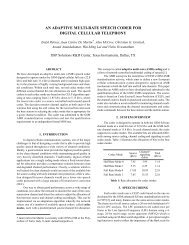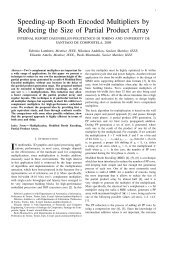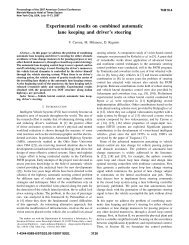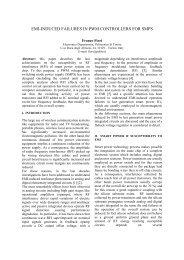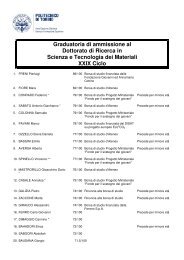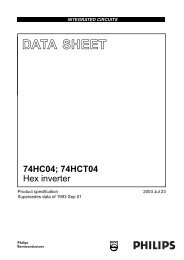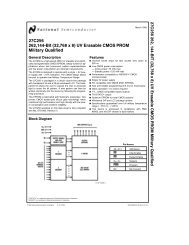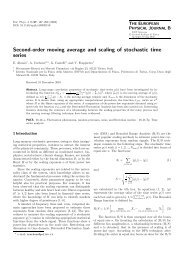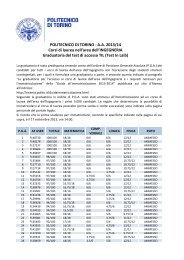Create successful ePaper yourself
Turn your PDF publications into a flip-book with our unique Google optimized e-Paper software.
The Stop condition provides a Timer Enable/Disable function. The CK down divided<br />
modes are scaled directly from the CK oscillator clock. If the external pin modes are<br />
used for Timer/Counter1, transitions on PB1/(T1) will clock the counter even if the pin is<br />
configured as an output. This feature can give the user software control of the counting.<br />
Timer/Counter1 – TCNT1H<br />
AND TCNT1L<br />
Bit 15 14 13 12 11 10 9 8<br />
$2D ($4D) MSB TCNT1H<br />
$2C ($4C) LSB TCNT1L<br />
7 6 5 4 3 2 1 0<br />
Read/Write R/W R/W R/W R/W R/W R/W R/W R/W<br />
R/W R/W R/W R/W R/W R/W R/W R/W<br />
Initial Value 0 0 0 0 0 0 0 0<br />
0 0 0 0 0 0 0 0<br />
This 16-bit register contains the prescaled value of the 16-bit Timer/Counter1. To<br />
ensure that both the high and low bytes are read and written simultaneously when the<br />
CPU accesses these registers, the access is performed using an 8-bit<br />
temporary register (TEMP). This temporary register is also used when accessing<br />
OCR1A, OCR1B and ICR1. If the main program and interrupt routines perform access<br />
to registers using TEMP, interrupts must be disabled during access from the main program<br />
(and from interrupt routines if interrupts are allowed from within interrupt routines).<br />
• TCNT1 Timer/Counter1 Write:<br />
When the CPU writes to the high byte TCNT1H, the written data is placed in the<br />
TEMP register. Next, when the CPU writes the low byte TCNT1L, this byte of data is<br />
combined with the byte data in the TEMP register, and all 16 bits are written to the<br />
TCNT1 Timer/Counter1 register simultaneously. Consequently, the high byte<br />
TCNT1H must be accessed first for a full 16-bit register write operation.<br />
• TCNT1 Timer/Counter1 Read:<br />
When the CPU reads the low byte TCNT1L, the data of the low byte TCNT1L is sent<br />
to the CPU and the data of the high byte TCNT1H is placed in the TEMP register.<br />
When the CPU reads the data in the high byte TCNT1H, the CPU receives the data<br />
in the TEMP register. Consequently, the low byte TCNT1L must be accessed first for<br />
a full 16-bit register read operation.<br />
The Timer/Counter1 is realized as an up or up/down (in PWM mode) counter with read<br />
and write access. If Timer/Counter1 is written to and a clock source is selected, the<br />
Timer/Counter1 continues counting in the timer clock cycle after it is preset with the written<br />
value.<br />
Timer/Counter1 Output<br />
Compare Register – OCR1AH<br />
AND OCR1AL<br />
Bit 15 14 13 12 11 10 9 8<br />
$2B ($4B) MSB OCR1AH<br />
$2A ($4A) LSB OCR1AL<br />
7 6 5 4 3 2 1 0<br />
Read/Write R/W R/W R/W R/W R/W R/W R/W R/W<br />
R/W R/W R/W R/W R/W R/W R/W R/W<br />
Initial Value 0 0 0 0 0 0 0 0<br />
0 0 0 0 0 0 0 0<br />
38 AT90S8515<br />
0841G–09/01



